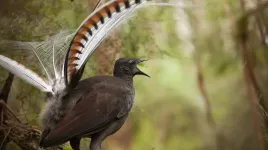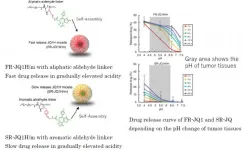From microsaws to nanodrills: laser pulses act as subtle machining tools
Industrial-grade materials processing on the sub-micron scale is enabled by spatially structured ultrashort laser pulses
2021-02-26
(Press-News.org) If light is strongly concentrated in time and space, resulting in extreme photon densities, it can enable interaction with all conceivable materials. By using these ultrashort laser foci, even transparent materials can be modified, even though they ordinarily would not interact. Short, focused laser pulses can overcome this transparency and allow energy to be deposited completely contact-free. The exact response of the material to the radiation can be very diverse, ranging from marginal refractive index changes to destructive microscale explosions that evacuate entire areas.
Using the laser pulses for optical machining allows for equally diverse material modification, such as separating or joining using the same laser system. Due to the extremely short exposure time and low degree of thermal diffusion, neighboring areas remain completely unaffected, enabling true micron-scale material processing.
In "Structured light for ultrafast laser micro- and nanoprocessing" by Daniel Flamm et al., various concepts are presented for manipulating the spatial distribution of laser light at the focus in such a way that particularly efficient and, thus, industrially suitable processing strategies can be applied. For example, customized nondiffracting beams, generated by holographic axicons, can be used to modify glass sheets up to millimeter scales using single-passes and feed rates of up to a meter per second. The application of this concept to curved substrates and the development of a laser-based glass tube cutting is a groundbreaking advance. This capability has long been needed by the medical industry for the fabrication of glass items such as syringes, vials and ampoules. The machined surfaces produce excellent edge quality and are free from micro debris, to meet the demands of the consumer and medical industry.
This paper also demonstrates the potential of a newly introduced 3D-beam-splitter concept. Here, 13 identical copies of the original focus are distributed across the three-dimensional working volume using a single focusing objective, serving to increase the effective volume of a weld seam. The material's response to the pulse is directly measured using transverse pump-probe microscopy confirming a successful energy deposition with 13 individual absorption zones. The conducted experiment represents a prime example of three-dimensional parallel processing based on structured light concepts and demonstrates increased throughput scaling by exploiting the performance of high-power, ultrashort pulsed laser systems.
The broad accessibility of liquid crystal displays and their application to beam shaping using holography has also led the materials processing community to adopt structured light concepts. However, these approaches have not yet been translated into industrial processing, mainly because such displays cannot handle high optical powers and energies as well as the high programming effort required to construct digital holograms.
This paper was able to report significant progress on this front. With the presented double illumination concept, the liquid crystal display modulates both amplitude and phase of the illuminating optical field. By applying digital amplitude masks, arbitrary intensity profiles can be generated, offering benefits for formation of high spatial frequency, fine metal masks. The adapted flat-top intensity profiles depicted in the manuscript are generated without using complex Fourier coding strategies, making the concept a promising candidate for future digital optical processing heads.
INFORMATION:
Read the original research article by Daniel Flamm et al., "Structured light for ultrafast laser micro- and nanoprocessing," Opt. Eng. 60(2), 025105 (2021), doi 10.1117/1.OE.60.2.025105
[Attachments] See images for this press release:

ELSE PRESS RELEASES FROM THIS DATE:
2021-02-26
Based on a manual recently discovered in a 3,500-year-old medical papyrus, University of Copenhagen Egyptologist Sofie Schiødt has been able to help reconstruct the embalming process used to prepare ancient Egyptians for the afterlife. It is the oldest surviving manual on mummification yet discovered.
In ancient Egypt, embalming was considered a sacred art, and knowledge of the process was the preserve of very few individuals. Most secrets of the art were probably passed on orally from one embalmer to the other, Egyptologists believe, so written evidence is scarce; until recently, only two texts on mummification had been identified.
Egyptologists were therefore surprised to find a short manual on embalming in a medical text that is primarily concerned with ...
2021-02-26
"Everyone's unique" is a popular maxim. All people are equal, but there are of course individual differences. This was no different with dinosaurs. A study by researchers at the University of Bonn and the Dinosaur Museum Frick in Switzerland has now revealed that the variability of Plateosaurus trossingensis was much greater than previously assumed. The paleontologists examined a total of 14 complete skulls of this species, eight of which they described for the first time. The results have now been published in the scientific journal "Acta Palaeontologica Polonica".
Plateosaurus lived during the Late Triassic, about 217 to 201 million years ago. "With well over 100 skeletons, some of them completely preserved, ...
2021-02-26
The latest developments in fluorescence microscopy make it possible to image individual molecules in cells or molecular complexes with a spatial resolution of up to 20 nanometres. However, under certain circumstances, an effect occurs that falsifies the results: the laser light used can cause very reactive oxygen molecules to form in the sample. These can then damage the fluorescent dyes used to such an extent that they no longer fluoresce. Among microscopy experts, this effect is known as photobleaching.
However, various fluorescent dyes can also be transformed by photobleaching so that they absorb light of shorter wavelengths. "A previously red fluorescent dye then glows green. Its fluorescence ...
2021-02-26
A study by researchers at William & Mary's Virginia Institute of Marine Science suggests that continued warming of Atlantic coastal waters may enhance the spread of invasive blue catfish within the Chesapeake Bay and other estuaries along the U.S. East Coast.
The research, by Drs. Vaskar Nepal and Mary Fabrizio of VIMS, appeared in a recent issue of PLOS ONE. It builds on an earlier study by the two authors showing that blue catfish can better tolerate salinity spikes than most freshwater fishes, and thus may be able to expand their range downstream into mainstem Chesapeake waters, and from there into new Bay tributaries and even Delaware Bay. "Blue cats" were introduced to tidal freshwater stretches of the James, York, and Rappahannock rivers during the 1970s and 1980s ...
2021-02-26
Researchers at the Lady Davis Institute (LDI) at the Jewish General Hospital have discovered that increased levels of the protein OAS1 are associated with reduced mortality and less severe disease requiring ventilation among patients with COVID-19. Using drugs that boost OAS1 levels could be explored to try to improve these outcomes. The findings are published today in Nature Medicine.
"Our analysis shows evidence that OAS1 has a protective effect against COVID-19 susceptibility and severity," explains Dr. Brent Richards, a senior investigator at the LDI's Centre for Clinical Epidemiology and Professor of Medicine, Human Genetics, Epidemiology and Biostatistics at McGill University. "This is a very ...
2021-02-26
A new study using leading edge technology has shed surprising light on the ancient habitat where some of the first dinosaurs roamed in the UK around 200 million years ago.
The research, led by the University of Bristol, examined hundreds of pieces of old and new data including historic literature vividly describing the landscape as a "landscape of limestone islands like the Florida Everglades" swept by storms powerful enough to "scatter pebbles, roll fragments of marl, break bones and teeth."
The evidence was carefully compiled and digitised so it could be used to generate for the first time ...
2021-02-26
NEW YORK, NY (Feb. 26, 2021)--People who took statins to lower cholesterol were approximately 50% less likely to die if hospitalized for COVID-19, a study by physicians at Columbia University Vagelos College of Physicians and Surgeons and NewYork-Presbyterian has found.
"Our study is one of the larger studies confirming this hypothesis and the data lay the groundwork for future randomized clinical trials that are needed to confirm the benefit of statins in COVID-19," says Aakriti Gupta, MD, a cardiologist at NewYork-Presbyterian/Columbia University Irving Medical Center and one of the co-lead authors of the study.
"If their beneficial effect bears out in randomized clinical trials, statins could potentially prove to be a low-cost and effective therapeutic ...
2021-02-26
Ithaca, NY--Famous for their uncanny ability to imitate other birds and even mechanical devices, researchers find that Australia's Superb Lyrebird also uses that skill in a totally unexpected way. Lyrebirds imitate the panicked alarm calls of a mixed-species flock of birds while males are courting and even while mating with a female. These findings are published in the journal Current Biology.
"The male Superb Lyrebird creates a remarkable acoustic illusion," says Anastasia Dalziell, currently a Cornell Lab of Ornithology Associate and recent Cornell Lab Rose Postdoctoral Fellow, now at the University of Wollongong, Australia. "Birds gather in mobbing flocks and the ruckus they make is a potent cue of a predator nearby. The ...
2021-02-26
A common barnacle could be used to help trace missing persons lost at sea, according to research by UNSW Science.
Researchers from the Centre for Marine Science and Innovation have developed an equation that can estimate the minimum time an object has spent drifting at sea by counting the number of Lepas anserifera attached to the object.
They also developed an equation which can help plot possible drift paths of a missing boat.
"We saw this opportunity that Lepas could possibly fill in this gap in that marine forensic process and possibly contribute (to finding missing people)," study lead author Thomas ...
2021-02-26
February 26, 2021 - Kawasaki, Japan: The Innovation Center of NanoMedicine (Director General: Prof. Kazunori Kataoka, Location: Kawasaki in Japan, Abbreviation: iCONM) reported in ACS Nano (Impact Factor: 14.588 in 2019) together with the group of Prof. Yu Matsumoto of Otorhinolaryngology and Head and Neck Surgery (Prof. Tatsuya Yamasoba) and the group of Prof. Horacio Cabral of the Department of Bioengineering (Prof. Ryo Miyake) in the University of Tokyo that the efficacy of polymeric nano-micelles with different drug activation profile depends on the expression level of c-Myc, one of the major proto-oncogene, has been developed. See: https://pubs.acs.org/doi/10.1021/acsnano.1c00364
It ...
LAST 30 PRESS RELEASES:
[Press-News.org] From microsaws to nanodrills: laser pulses act as subtle machining tools
Industrial-grade materials processing on the sub-micron scale is enabled by spatially structured ultrashort laser pulses








